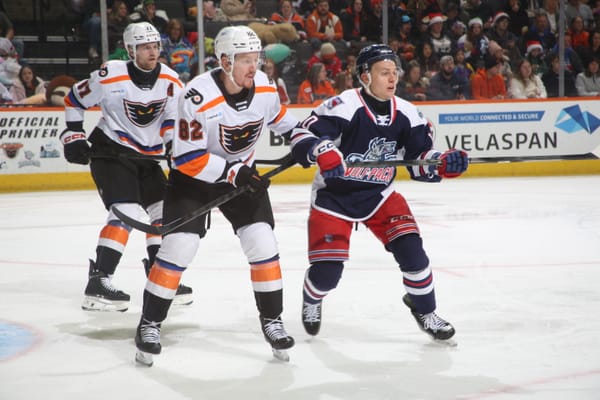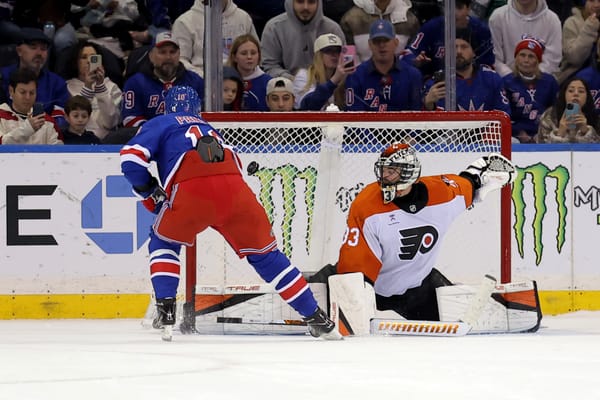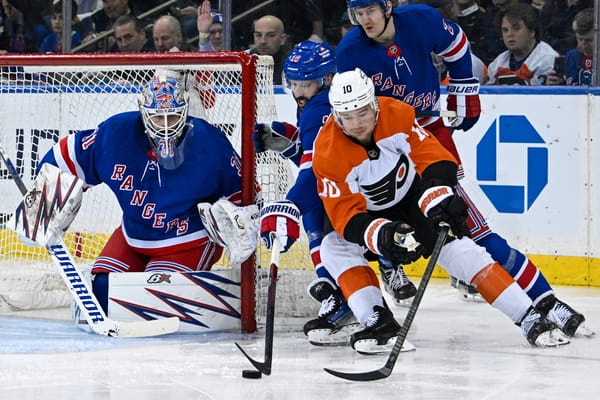Blueshirt Banter Reader Mailbag
You have the questions, we have things that sound like answers.
The New York Rangers may be in a somewhat unfamiliar position come the 2018 trade deadline, as they’re more likely destined to be sellers instead of buyers.
Rebuilding a team that has had Cup aspirations for a decade is no small thing, especially to loyal fans, so, Blueshirt Banter put the call out for questions from fans and readers about what comes next for the Rangers and what the team should, shouldn’t, and may or may not do. It’s time for our BSB Rangers mailbag!
What are the pros/cons of trading way before deadline?
— Andrew Metrick (@metricka) January 31, 2018
Mike
The biggest risk of selling before deadline day is putting an end to a bidding war prematurely. If you’re the general manager of a team that is committed to selling and rebuilding, you want a bidding war for your assets to have every opportunity to reach its full potential – although, there have been stories of greed derailing deals and putting teams in awkward positions.
If a general manager chooses to sell before deadline day, they have the benefit of dictating terms without the pressure of the ticking clock. There is also the advantage of setting a market price before it is established. For example: it might take a second round pick to add a third pairing defenseman on deadline day, whereas one could acquire a third pair blueliner for much less three weeks before deadline day.
It’s impossible to know when the iron is at its hottest. Every “well why didn’t they do THIS?” rant comes from a position blessed with hindsight.
Shayna
I totally agree with Mike here. Setting the market price definitely has some advantages and disadvantages. General managers don’t have the benefit of hindsight, so a transaction has to be assessed when it happens – and that assessment usually should come down to whether it was the right move for the team at the time the trade occurred.
The problem though, is that the market price could just be a baseline, and go up from there since the supply of available players at whatever position just dwindled. So if the Rangers, in theory, moved their first-line center – regardless of whether or not the price seemed fair at the time – they could set the market. If another team moved their first-line center of a similar value later, but was the beneficiary of a higher return, the Rangers’ trade is likely going to be compared to that next trade and the original assessment could become skewed in hindsight because of what the other team was able to acquire.
Trading before the deadline comes with obvious risks because the market can change closer to February 26 based on the number of players still available, as well as the demand for those players. If it’s a fair trade at the time, then the following trades shouldn’t influence how that trade is viewed, but it’s still likely to happen regardless.
On the other hand, there’s a risk of the valuations and potential return decreasing closer to the deadline, which could pose an even greater problem for a team looking to rebuild.
I’m curious on your thoughts about Sather. How influential is he? What happens when he eventually leaves the org?
— Larry Bubbs (@LarryBubbs) January 31, 2018
Shayna
Glen Sather is still the President of the New York Rangers and unquestionably still has influence in the decision-making process. The Rangers’ organization has displayed their respect for Sather throughout his time as general manager and president, and I don’t think it’s wavered over the years.
Of Jeff Gorton’s transactions, I think the Eric Staal trade stood out as the most Sather-like, and I wouldn’t be surprised if he directed it, because it’s much more in line with his dealings than Gorton’s so far.
It’s not rare for someone in that position to have an influence on the process though – just look at John Davidson in Columbus, for example. Whoever takes over for Sather, I’d assume will still have a similar authority, just maybe not to the same extent. I think that depends on their relationship to the team, as well as their track record.
Mike
I’m not a big fan of speculation and have done my best to steer clear of it in my published work, but with that being said Sather’s influence over the front office is utterly fascinating. So, let’s talk about it.
One can’t help but wonder just how much influence he has over Gorton and his roster decisions. Even at 74-years-old Sather is still very much a personality. He’s been with the organization since the 2000-2001 season and is only three years removed from the role of general manager, so I think we can safely assume that his voice still commands a great deal respect in the front office. As Shayna mentioned the Eric Staal trade had Sather’s fingerprints all over it.
The Rangers, perhaps more than any other NHL team, need new, fresh ideas. They need something different. When Sather places his gnawed-up, unlit cigar in an MSG ashtray for the last time it will open the door for change. And given the Rangers track record in contracts and trades since 2000-2001, that will likely be a good thing.
What do you guys see as a realistic return for a Ryan McDonagh trade? I've seen some rumors that are tantalizing to say the least, but I don't think the leafs are giving up Nylander or Marner in this deal.
— Bob Kawa (@bob_kawa) January 31, 2018
What sort of player/pick package would you be happy with for McDonagh at the deadline? As nice as it would be to get Marner or Nylander, I dont really see it happening
— Jake Lester (@thesnake68) January 31, 2018
Mike
The Rangers should move Ryan McDonagh, but only if there is an adequate return for the captain. And, as we all know, the Toronto Maple Leafs are a very intriguing trade partner. We’ve also heard that Tampa Bay and Boston are leading suitors. So, there is a pretty interesting wish list to choose from.
We’ve heard names like Mitch Marner, William Nylander, and Zach Hyman attached to McDonagh. And that sounds good right? But is it too good to be true? Uncle Bob thinks so.
“I also do see where the Rangers are going to entertain offers on Ryan McDonagh, he’s got a year left on his contract, he’ll be 29 to start next season.” McKenzie told TSN Radio 1050 Toronto. “But I don’t see the Leafs giving up one of their young pillars up front - and I do see Matthews, Marner and Nylander as the three pillars up front - not for that type of defenceman.”
More recently McKenzie said that the Rangers will dutifully listen to offers on McDonagh and Zuccarello, but the priority will be trading Grabner and Nash.
The McDonagh trade, if it happens, is something that Gorton and the front office cannot afford to bungle. In my opinion the Rangers need to prioritize acquiring blue chip defensive and center prospects, or the early draft picks to acquire them. There are a few intriguing defenders in the system, but no single prospect with a tantalizingly high ceiling spare Sean Day.
Shayna
I think either William Nylander or Mitch Marner plus draft picks or other prospects would be an ideal return for the Rangers, and it could certainly be a mutually beneficial for both teams. Then again, if the Maple Leafs can afford to re-sign McDonagh for the value he likely asks for, they may prefer to direct that cap space towards one of their three “pillars.”
The Tampa Bay Lightning have come up recently.
The Sportsnet segment on McDonagh and smoke with Tampa. #NYR pic.twitter.com/DnrW7qivrW
— Tom Urtz Jr. 🥅📊📉🎰 (@TomUrtzJr) February 4, 2018
I think they have some interesting prospects, but I’m not sure they have enough to entice the Rangers to move McDonagh. I’d see them as suitors for Nash or Grabner more-so. I’m also intrigued to see how they manage to handle the salary cap situation (if they were to extend him), or where he slots in the lineup with Victor Hedman on the left side of the first pair and lefty Mikhail Sergachev behind him. They do have all of their draft picks for the next three seasons which could be moved, but then again, they likely aren’t going to be too high in the draft order.
Nylander is closer to the high end of the spectrum in terms of skilled, young players at the NHL level, and acquiring that talent like that isn’t going to be easy. Ideally, the Rangers find a young player with a high ceiling, hopefully one that is NHL ready, and can also attain other prospects and draft picks in the trade.
Off the top of my head, the most similar deal to a potential McDonagh trade I can think of in recent seasons would be the deal that brought Keith Yandle to New York. If they move McDonagh before the deadline this season, that gives a team at least two chances at the postseason with him, so that should increase his value to playoff contenders (also similar to Yandle). What could work against him though, is the fact that he’s been dealing with nagging injuries.
But like Mike said, if the Rangers are going to move McDonagh, the return has to be worth it. They can’t afford move him for the sake of making a change or to preserve cap space.
If Zucc gets dealt, what’s the ideal return?
— Lou Venditti (@everyoneleftlou) February 1, 2018
Shayna
If Mats Zuccarello gets dealt, and I think that should rightfully be a big “if” because of his skill level and impact on this team, I think it should be the last of the Rangers’ transactions. I think the focus has to be on the unrestricted free agents first, so the Rangers can gauge what they need moving forward from their more valuable assets.
At this point, I think it’s less of an “if” and more of a “when” Ryan McDonagh is moved, so after that, and all the pending free agents are moved, then the Rangers can assess their situation and determine whether or not moving Zuccarello is actually necessary, and what they need moving forward.
If McDonagh is moved and none of their transactions bring in young defensemen, that may be an area for the Rangers to explore – although, I’d first want to see if any of their AHL defensemen are NHL ready first.
Mike
I happen to believe that Zuccarello is a prime candidate to be a captain of this team, but that statement comes wreathed in sentimentality. There’s no replacing a guy like Zuccarello. You can replace his production and find another top-six winger, but if Lundqvist is the beating heart of this team Zuccarello is its soul. He may be more vital to team than its current captain. And with a rebuild just around the corner, that is something to keep in mind.
To answer the question I think Gorton should follow the blueprint of the Derick Brassard trade: get a young, hungry guy who can make an immediate impact and an early draft pick or two. I would imagine that there are plenty of teams who would pay that price or even more for the Norwegian winger.
1. If Nash goes, do they bring him back at <4.75 AAV? 2. How much is Mac worth to trade? 3. Would Hank ever agree to a trade? 4. Is Hayes worth trading, re-signing, or taking RFA comp? 5. Can we clear enough space to sign Seguin next summer, while preserving enough talent to win?
— Nick C (biffmarkie, if you IM me) (@biffmarkie) January 31, 2018
Mike
1. If the Rangers trade Nash as a rental, it might be tricky buying him back in free agency. He is attached to New York, but he has a young family. Remember, he’ll be 34 on July 1. Nash may not want to be a part of a rebuild after what he went through in Columbus and he may also want more security than something like a two-year deal.
Nash is clearly still a useful player, but he’s a hard guy to put a price tag on because of his diminishing production.
2. All the galleons in Gringotts, my friend.
3. Nope.
4. The Rangers are in the uncomfortable and unfortunate condition of needing Kevin Hayes very badly, but they only have themselves to blame. If you remove Hayes from the equation the team’s already suspect center depth becomes even more of an issue. Shayna explains this issue in greater detail in her answer below.
5. Something tells me the Rangers should avoid Seguin like poison. He’s something of a one-dimensional player and is going to cost a king’s ransom to sign in two years. The way forward is with cheap, young talent. When the Rangers go after the next big fish in the free agency pond, they need to be careful.
Shayna
1. If Nash is moved, I definitely think the Rangers should consider signing him in free agency. I think $4.75 million in cap space is actually a little high; I’d rather see closer to $3.5 million - $4 million, but that also depends on the length of the contract (longer the contract, lower the cap hit, and vice versa).
But Mike brings up a great point about the Rangers rebuild – returning to the Rangers likely come with a lower cap hit than he can get from teams with a more flexibly salary situation – would Nash want to not only take a lower salary and be on a team in rebuild mode?
2. McDonagh is worth a lot, see our earlier answers.
3. I think this story from Larry Brooks should clear that up. I wouldn’t blame Henrik Lundqvist at all for wanting a trade out of New York, considering the teams that have been constructed in front of him, as well as some of their tactical decisions.
4. No, Kevin Hayes shouldn’t be traded, and should definitely be re-signed. Even with Lias Andersson and Filip Chytil, the Rangers still aren’t the strongest team down the middle, so they certainly can’t afford to lose Hayes – especially not when considering how pivotal his role is without a two-way center like Stepan in the lineup. Hayes has one of the lowest zone start ratios on the team (41.46 at 5-on-5) and has taken the second highest percentage of defensive zone starts (36.8 percent at 5-on-5) of the offense so far this season. Plus, he’s been effective on the penalty kill. He’d have even more value if he was actually used on the power play on a consistent basis. Unless the Rangers have another center that can play those minutes, moving him really isn’t an option.
Had J.T. Miller actually been used as a center all season and demonstrated that he can thrive in that position, this would be a different conversation. Because that hasn’t happened, and he’ll be looking for a raise as well; if anything, he’s the more expendable pending restricted free agent, at least in my opinion.
5. While Tyler Seguin is a talented player, I don’t think he’s an attainable option for the Rangers, and I think that’s for the best. Right now, his cap hit is only $5.75 million and he’s going to look for a significant raise at 27-years-old, when he’s likely to already be on the decline. The Rangers should look to be contenders for years to come, so their focus should be shifted on less costly, and younger options.
Special thanks to Zukey McDoggerson, resident doggo mascot of Blueshirt Banter.




